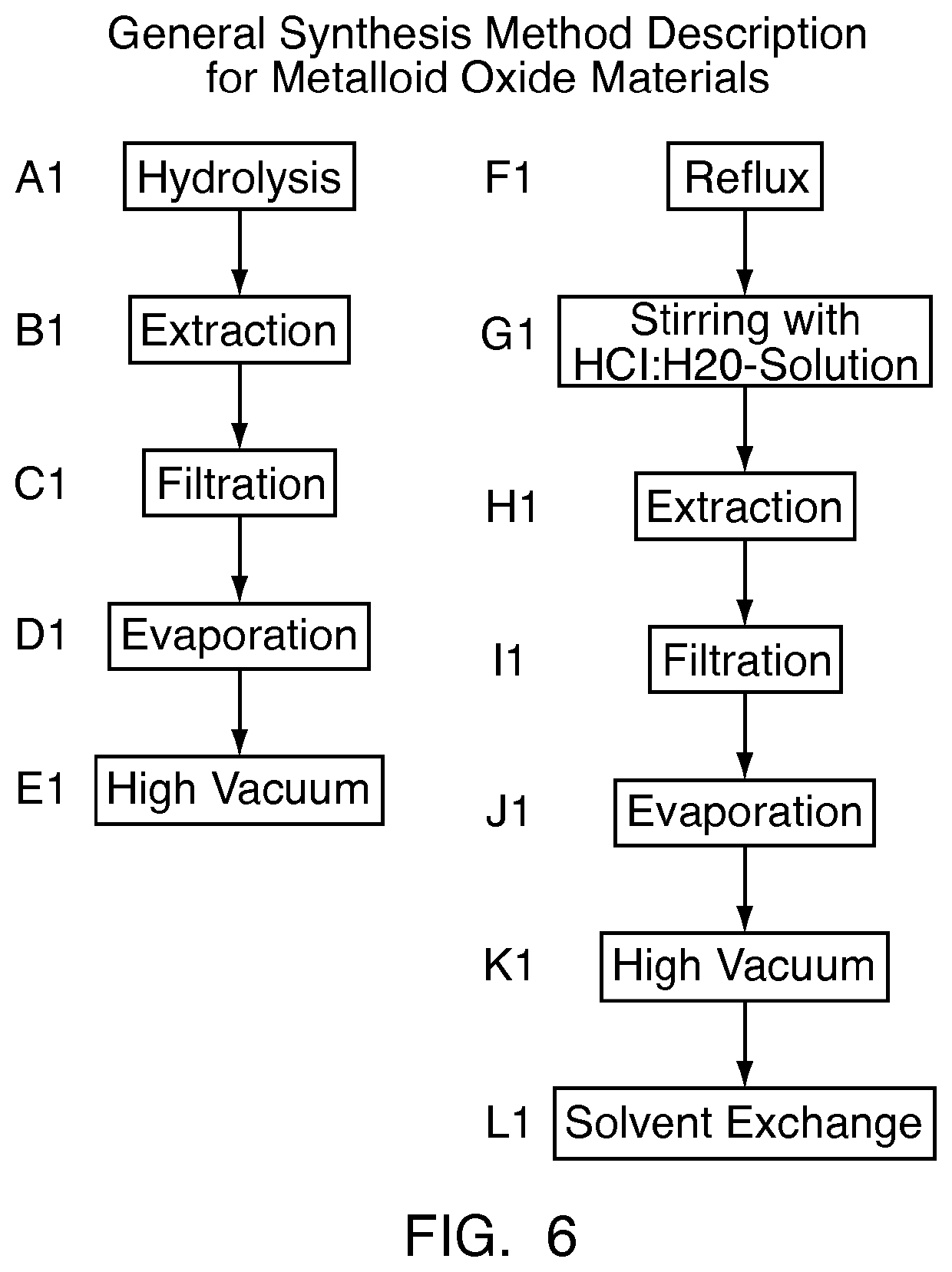Method of making a photonic crystal device and photonic crystal device
a technology of photonic crystal and oled, which is applied in the field of making a photonic crystal device, can solve the problems of poor external efficiency of the device, inability to capture all or nearly all of the light produced, and the light output of the emissive elements of the oled is trapped within the device, etc., and achieves the effect of efficiently extracting the light from the devi
- Summary
- Abstract
- Description
- Claims
- Application Information
AI Technical Summary
Benefits of technology
Problems solved by technology
Method used
Image
Examples
polymer example i
brid Polymer 1
[0132]Ti(iOPr)4 (0.05277 mol) was placed in a round bottom flask.TiCl4 (0.05277 mol) was added by syringe and needle. The solution containing a white solid was stirred at room temperature (RT) for 10 min. 125.04 g of 2-isopropoxyethanol was added and the clear yellow solution was stirred at room temperature for 30 min. (Nd=1.4332). 3.80 g of H2O (0.21099 mol) was added and the reaction solution was stirred at room temperature for an additional 5 min (Nd 1.4322). 21.36 g of TEA (0.211088 mol) was added to neutralize the reaction mixture. The obtained white suspension was stirred at room temperature for 2 h. The white reaction suspension was filtrated using pressure filter (filter paper size 0.45 um) Nd=1.4235 and pH=6.5-7 (pH-paper was used for determination). The amount of material in grams after filtration was 92.71 g. An acidic water solution (nitric acid, HNO3, 0.0652 mol) was added to the reaction mixture. Then, metacrylic acid (MAA, 0.1304 mol) was added dropwise ...
polymer example ii
rid Polymer 1
[0133]TaCl5 (0.007342 mol) was placed to a round bottom flask and methanol (MeOH) (26 ml) was added. To the clear reaction solution Ta(OEt)5 (0.007342 mol) was added. The clear reaction solution was stirred at room temperature for 2 h. Solvent exchange from MEOH to 2-isopropoxyethanol (5×) was carried out using rotary evaporator (p=200-51 mbar, tbath=40° C.). The clear reaction solution was stirred at room temperature for a few minutes and after that the reaction solution was neutralized using TEA (m=4.62 g; 0.04566 mol). The white suspension was stirred at room temperature for 2 h and then filtrated using pressure filter (0.45 um). The clear solution obtained was placed in freezer overnight. After this the suspension was filtrated. The solvent used during the synthesis was removed by rotary evaporator (p=100-1 mbar, t(bath)=40° C., at 1 mbar for 10 min). 6.82 g of IPA:MeOH:1-butanol solution (6:3:1) was added as processing solvent to the material. Clear reaction soluti...
polymer example iv
1
[0150]Trifluoropropyltrichlorosilane (26.38 g, 0.1139 mol) and allyltrichlorosilane (13.32 g, 0.07596 mol) were weighed to a round bottom flask. 183 g of dichloromethane (DCM) was added. This clear DCM solution was added using a dropping funnel to another flask in an ice bath containing a DCM:H2O solution 23 ml:160 ml. The DCM solution was added in 60 min. The temperature was maintained during addition between 2-5° C. After addition, the reaction mixture was stirred at room temperature (RT) for 120 min. After this the reaction mixture was placed in a separation funnel and 120 g of DCM was added. The DCM and H2O layers were separated. The DCM phase was extracted six (6) times using 65 ml of distilled water in each extraction run. The pH of the DCM-phase was, after the last extraction, neutral. The DCM-layer was filtrated once using a filter paper. DCM was removed by evaporation (p=400-2 mbar, T(bath)=40° C.). The vacuum was maintained below 18 mbar for 5 min. After this, the clear m...
PUM
| Property | Measurement | Unit |
|---|---|---|
| wavelength | aaaaa | aaaaa |
| work function | aaaaa | aaaaa |
| refractive index | aaaaa | aaaaa |
Abstract
Description
Claims
Application Information
 Login to View More
Login to View More - R&D
- Intellectual Property
- Life Sciences
- Materials
- Tech Scout
- Unparalleled Data Quality
- Higher Quality Content
- 60% Fewer Hallucinations
Browse by: Latest US Patents, China's latest patents, Technical Efficacy Thesaurus, Application Domain, Technology Topic, Popular Technical Reports.
© 2025 PatSnap. All rights reserved.Legal|Privacy policy|Modern Slavery Act Transparency Statement|Sitemap|About US| Contact US: help@patsnap.com



